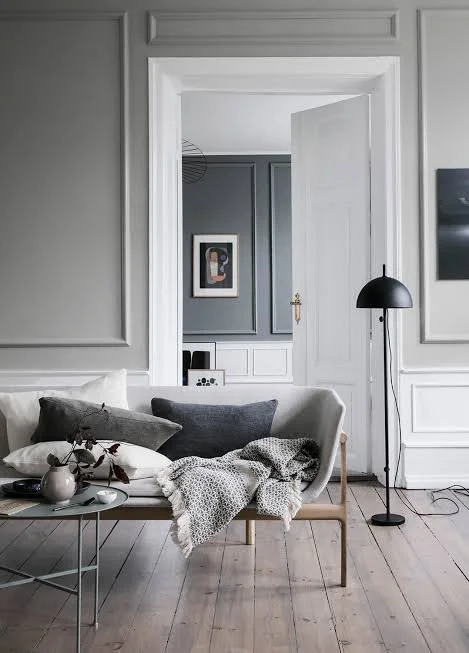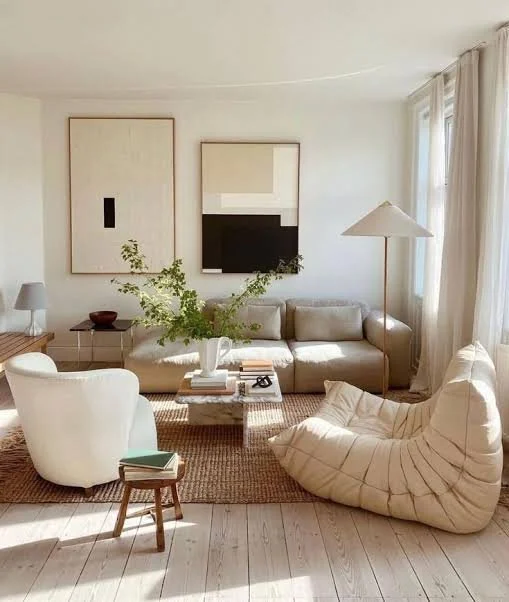Is Green the New Millennial Grey? A Real Talk on Trends, Colour Cycles and Dopamine Décor
By Loui Burke – your friend in home and hosting
Let’s clear something up: green is not the new grey. And dopamine décor hasn’t “taken over” neutral interiors. That’s not how it works, and as someone who studied design and trend forecasting, let me give you the actual rundown on what’s happening in the world of interiors.
The Real Successor to Grey? Beige.
You’ve probably heard people ask, “What’s the new millennial grey?” expecting the answer to be sage green or something wildly colourful. But the truth is far more… beige. Literally.
Trends don’t disappear overnight. They move like a pendulum.
Picture it swinging: for years we lived in grey homes – cool-toned, concrete-inspired, minimal. Then came greige (that awkward transitional shade between grey and beige), and now we’ve landed in full beige territory. Think creamy walls, linen sofas, mushroom tones.
Eventually, we’ll tire of beige too, and the pendulum will swing again – maybe back to grey or toward something we haven’t even noticed yet. That’s the rhythm of trend.
Okay, But What’s the New Green?
Here’s where it gets juicy. If you’re asking what’s replaced green as the colour, it’s not teal, mint, or avocado. It’s burgundy. Surprised?
Let me explain.
Colour trends also follow cycles, and they’re often tied to the colour wheel. The opposite of green is red. So after years of forest green kitchens, olive velvet sofas, and eucalyptus everything, we swung to brown (a muddy middle ground), and now we’re seeing a rise in burgundy – that deep, wine-toned red popping up in tiles, fabrics, and paint colours.
So:
Green → Brown → Burgundy.
Again, a rhythm. A rhyme. And yes, a reason.
What About Dopamine Décor?
Now, dopamine décor is having a moment. You’ve probably seen it – bright colours, clashing patterns, a joyful, chaotic layering of “stuff.” But it’s not exactly replacing neutrals – it’s responding to them.
It’s what happens when people rebel against years of beige boxes and minimalism. But here’s the kicker: dopamine décor isn’t always accessible. Why? Because colourful furniture and décor cost more.
Brands play it safe. They mass-produce neutral tones because statistically, more people buy them. If you sit five people down and offer beige or bright blue, most will default to the neutral. So when it comes to business decisions, beige wins. That’s why your favourite colourful lamp is $400, and the oatmeal one is on clearance in every store.
Is Dopamine Décor Here to Stay?
Honestly? It depends. Some of it is genuinely expressive – people embracing colour, maximalism, and personal taste. But a lot of it is chaotic for chaos’ sake. And that doesn’t always age well.
Throwing five random bold pieces together and calling it a day can work, but mostly because it’s so wrong, it somehow feels right. That doesn’t mean it will feel right in five years.
So What’s the Takeaway?
Design has a strategy. Trends evolve slowly. And while people like to pretend colour trends are random or viral, they’re usually predictable if you know what to look for.
So no, green is not the new grey. Beige is.
And no, dopamine décor hasn’t taken over – it’s just louder right now.
But as always, what matters most is that your home reflects you, not just what’s trending.
Until next time,
Loui x
Your guide to home, hosting, and living with intention.






